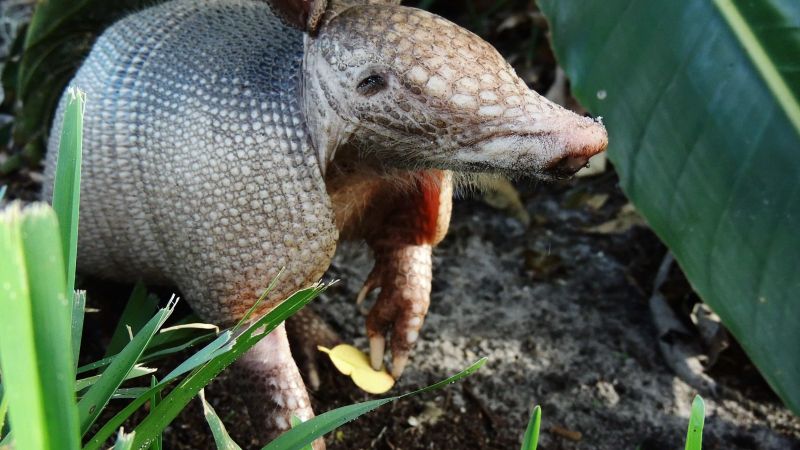 What do armadillos and humans have in common? They can both be infected with leprosy, one of the oldest and most dreaded diseases known to man. In fact, without this unusual mammal from the Americas very little progress would have been made in the search for a treatment for the disfiguring disease. And it seems to be all down to body temperature!
What do armadillos and humans have in common? They can both be infected with leprosy, one of the oldest and most dreaded diseases known to man. In fact, without this unusual mammal from the Americas very little progress would have been made in the search for a treatment for the disfiguring disease. And it seems to be all down to body temperature!
The cause of leprosy is a bacterium calledMycobacterium leprae, which multiplies very slowly – about once every two weeks – and has never been grown to a useful quantity for experiments in cell culture. Most animals, including rats, guinea pigs and rabbits, are immune to the disease and mice exhibit only a very mild form that does not affect the nervous system like it does in people. Without a way to grow the bacterium, and an animal model in which to study its effects and test drugs, scientists stood little hope of understanding the disease and developing an effective treatment.
Eleanor Storrs discovered the nine-banded armadillo’s susceptibility to leprosy in the late 1960s while searching for a suitable animal model to use for her leprosy research. In people the bacterium grows in the extremities, ears and fingers for example, but in armadillos the disease penetrates deeper, affecting the organs. Scientists believe this is down to its unusually low body temperature of 33 degrees Celsius, which is about 5 degrees lower than the temperature of humans and other mammals. The discovery gave researchers a perfect natural incubator to grow large quantities of M. leprae for their experiments as well as an animal on which drugs can be tested. Another advantage of the armadillo is that it gives birth to four genetically identical offspring. Researchers can use two of the quadruplets as “untreated controls” in experiments; as the animals have the same genetic makeup and developed together in the womb, any differences between “treated” and “untreated” animals are very likely to be down to the experimental treatment.
Since the initial discovery of leprosy in armadillos, scientists have been using the animal to develop a vaccine. However, trials in humans have failed to show any to be sufficiently effective, although research is still ongoing. The use of armadillos has helped scientists develop a test for leprosy, called the lepromin skin test, which uses proteins purified from M. leprae bacteria grown in the armadillo, and a range of antibiotic multi-drug treatments, which are effective in armadillos and humans if the disease is caught early enough. As one of the few animals that develop leprosy throughout the body, armadillos are also a valuable source of infected nerve tissue for use in experiments to better understand how to protect the nervous system of people affected by the disease .
Armadillos have been used in medical research since the mid-1800s. Our understanding of embryology and reproductive biology has been greatly aided by studies of the armadillo’s unusual quadruplets. In fact, before turning to leprosy research, Eleanor Storrs was using armadillos to study reproduction. As a result of its value to a range of different research areas, scientists sequenced its genome in 2003, giving scientists around the world a new insight into the animal’s biological secrets.
A recent study of the bacterial M. leprae DNA from the skeletons of five people who died from leprosy in England, Sweden and Denmark between the 10th and 14th centuries has revealed that the pathogen has changed very little over the past 1000 years. Leprosy infections in Europe today are very rare as an estimated 95% of the population have developed immunity, possibly because the bacteria has changed so little and so people’s immune systems have become adept at fighting the infection. However globally leprosy remains a significant problem with around 225,000 new cases recorded annually. Research using armadillos, mice and many non-animal methods is still needed if we are to eradicate this disease completely.
Additional references
1 Kirchheimer WF, Storrs EE. (1971) Attempts to establish the armadillo (Dasypus novemcinctus Linn.) as a model for the study of leprosy. Report of lepromatoid leprosy in an experimentally infected armadillo. Int J Lepr Other Mycobact Dis. http://www.ncbi.nlm.nih.gov/pubmed/4948218
2 Duthie MS, Gillis TP, Reed SG. (2011) Advances and hurdles on the way toward a leprosy vaccine. Hum Vaccin. http://www.ncbi.nlm.nih.gov/pmc/articles/PMC3323495/
3 Dhople AM, Williams SL. (1997) The activity of rifabutin against Mycobacterium leprae in armadillos. Int J Antimicrob Agents. http://www.ncbi.nlm.nih.gov/pmc/articles/PMC3323495/
4 Sharma et al. (2013) The armadillo: a model for the neuropathy of leprosy and potentially other neurodegenerative diseases. Dis Model Mech. http://www.ncbi.nlm.nih.gov/pubmed/23223615
5 Schuenemann VJ et al. (2013) Genome-Wide Comparison of Medieval and Modern Mycobacterium leprae. Science. http://www.sciencemag.org/content/early/2013/06/12/science.1238286
Last edited: 26 October 2022 17:56




